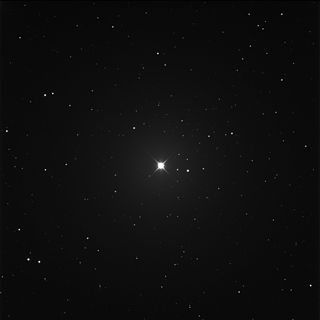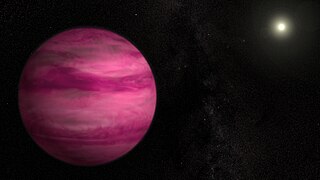Related Research Articles

70 Virginis is a binary star located 59 light years from the Sun in the equatorial constellation of Virgo, near the northern constellation border with Coma Berenices. 70 Virginis is its Flamsteed designation. The star is visible to the naked eye as a faint, yellow-hued point of light with an apparent visual magnitude of +4.97. It is drifting further away with a heliocentric radial velocity of +4.4 km/s and has a high proper motion, traversing the celestial sphere at the rate of 0.621 arc seconds per annum.

61 Virginis is the Flamsteed designation of a G-type main-sequence star (G7V) slightly less massive than the Sun, located 27.8 light-years away in the constellation of Virgo. The composition of this star is nearly identical to the Sun.

An F-type main-sequence star is a main-sequence, hydrogen-fusing star of spectral type F and luminosity class V. These stars have from 1.0 to 1.4 times the mass of the Sun and surface temperatures between 6,000 and 7,600 K.Tables VII and VIII. This temperature range gives the F-type stars a whitish hue when observed by the atmosphere. Because a main-sequence star is referred to as a dwarf star, this class of star may also be termed a yellow-white dwarf. Notable examples include Procyon A, Gamma Virginis A and B, and KIC 8462852.

Tau Boötis b, or more precisely Tau Boötis Ab, is an extrasolar planet approximately 51 light-years away. The planet and its host star is one of the planetary systems selected by the International Astronomical Union as part of NameExoWorlds, their public process for giving proper names to exoplanets and their host star. The process involved public nomination and voting for the new names, and the IAU planned to announce the new names in mid-December 2015. However, the IAU annulled the vote as the winning name was judged not to conform with the IAU rules for naming exoplanets.

Iota Virginis is a binary star in the constellation of Virgo. Its apparent magnitude is 4.08. Based on its parallax, it is assumed to be relatively nearby, at 72.5 light-years.

Chi Virginis is a double star in the constellation Virgo. Based upon parallax measurements, it is approximately 315 light-years from Earth. It has an apparent visual magnitude of 4.65, which is bright enough to be seen with the unaided eye under suitable viewing conditions.
HD 40979 is a triple star system in the northern constellation of Auriga. The combined brightness of this group lies below the typical limit of visibility to the naked eye at an apparent visual magnitude of 6.74. It is located at a distance of approximately 108 light years from the Sun based on parallax. The system is receding with a radial velocity of +32 km/s. It has a relatively high rate of proper motion, traversing the celestial sphere at the rate of 0.182″ per year.

A sub-brown dwarf or planetary-mass brown dwarf is an astronomical object that formed in the same manner as stars and brown dwarfs but that has a planetary mass, therefore by definition below the limiting mass for thermonuclear fusion of deuterium . Some researchers call them rogue planets whereas others call them planetary-mass brown dwarfs. They are sometimes categorized as Y spectral class brown dwarfs.

HW Virginis, abbreviated HW Vir, is an eclipsing binary system, approximately 563 light-years away based on the parallax measured by the Gaia spacecraft, in the constellation of Virgo. The system comprises an eclipsing B-type subdwarf star and red dwarf star. The two stars orbit each other every 0.116795 days.

A circumbinary planet is a planet that orbits two stars instead of one. The two stars orbit each other in a binary system, while the planet typically orbits farther from the center of the system than either of the two stars. In contrast, circumstellar planets in a binary system have stable orbits around one of the two stars, closer in than the orbital distance of the other star. Studies in 2013 showed that there is a strong hint that a circumbinary planet and its stars originate from a single disk.

QS Virginis is an eclipsing binary system approximately 163 light-years away from the Sun, forming a cataclysmic variable. The system comprises an eclipsing white dwarf and red dwarf that orbit each other every 3.37 hours.

61 Virginis b is an extrasolar planet, orbiting the 5th magnitude G-type star 61 Virginis, in Virgo. This planet has a minimum mass of 5.1 times that of Earth and is an example of a super-Earth planet. It orbits very close to the star, at a distance of 0.050201 AU with an eccentricity of 0.12. This planet was discovered on 14 December 2009 using the radial velocity method taken at Keck and Anglo-Australian Observatories.
HD 34445 b is an extrasolar planet which orbits the G-type star HD 34445, located approximately 150.5 light years away in the constellation Orion. This planet was discovered in 2004 and finally confirmed in 2009. This planet has a minimum mass two-thirds that of Jupiter and orbits about 2 AU from the parent star. However this planet orbits in a very eccentric path. The planet's distance from the star ranges from 0.86 to 3.16 AU however it spends its full orbit within the star's habitable zone.
HD 126614 Ab, or simply HD 126614 b, is an extrasolar planet which orbits the primary K-type star HD 126614 A, located approximately 240 light years away in the constellation Virgo. It was discovered on November 13, 2009. However, this planet has a highly eccentric orbit around its parent star. The planetary distance ranges from 0.94 AU to 3.61 AU. HD 126614 A also has the highest metallicity of any star hosting any exoplanets, at +0.56 dex.
59 Virginis is a G-type main-sequence star, located in constellation Virgo at approximately 57 light-years from Earth.

Gliese 504 b is a Jovian planet or brown dwarf located in the system of the solar analog 59 Virginis, discovered by direct imaging using HiCIAO instrument and AO188 adaptive optics system on the 8.2-meter Subaru Telescope of Mauna Kea Observatory, Hawaii by Kuzuhara et al. Visually, GJ 504 b would have a dull magenta color. It can be seen from Earth in the constellation Virgo.

HD 106906 b is a directly imaged planetary-mass companion and candidate exoplanet orbiting the star HD 106906, in the constellation Crux at about 336 ± 13 light-years (103 ± 4 pc) from Earth. It is estimated to be about eleven times the mass of Jupiter and is located about 738 AU away from its host star. HD 106906 b is an oddity; while its mass estimate is nominally consistent with identifying it as an exoplanet, it appears at a much wider separation from its parent star than thought possible for in-situ formation from a protoplanetary disk.
38 Virginis is an F-type main sequence star in the constellation of Virgo. It is around 108 light years distant from the Earth.

Maritza Soto Vásquez is a Chilean astronomer who discovered the exoplanets HD 110014 c, K2-237b, and K2-238b.
References
- De Medeiros, J. R.; Setiawan, J.; Hatzes, A. P.; Pasquini, L.; Girardi, L.; Udry, S.; Döllinger, M. P.; Da Silva, L. (2009). "A planet around the evolved intermediate-mass star HD 110014". Astronomy and Astrophysics . 504 (2): 617. Bibcode:2009A&A...504..617D. doi: 10.1051/0004-6361/200911658 .